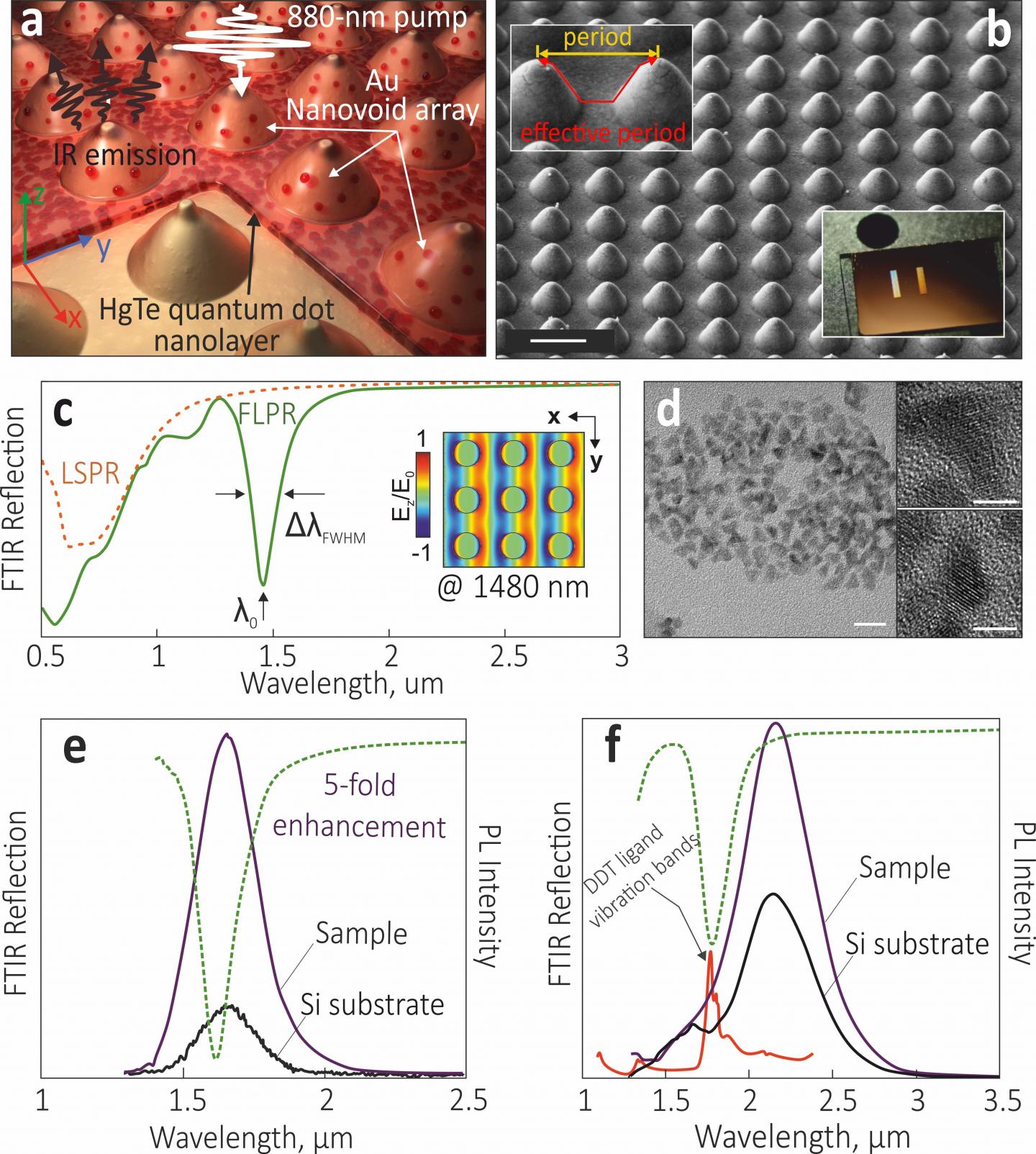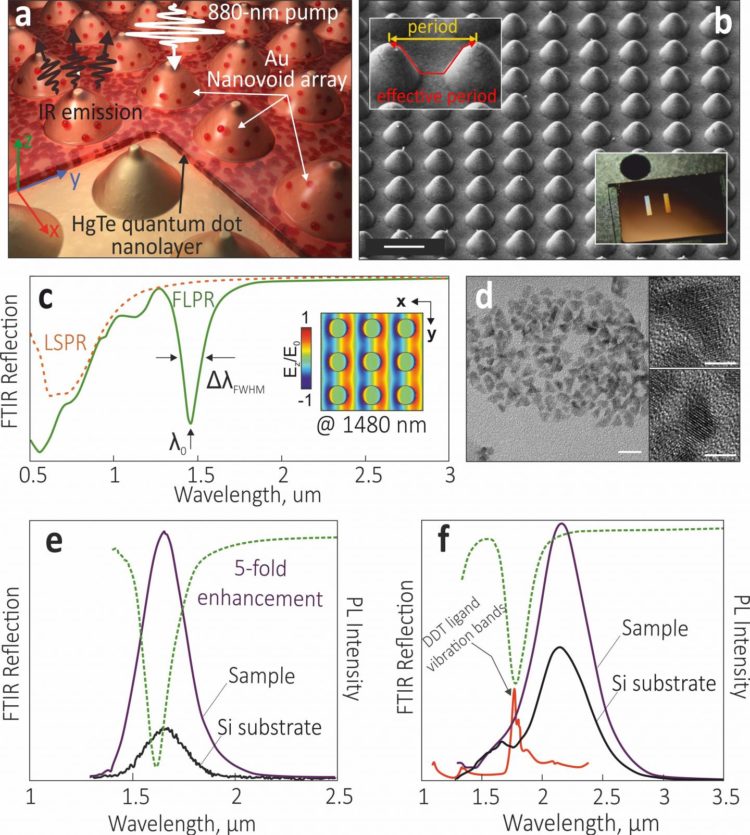
Credit: by A.A. Sergeev, D.V. Pavlov, A.A. Kuchmizhak, M.V. Lapine, W.K. Yiu, Y. Dong, N. Ke, S. Juodkazis, N. Zhao, S. V. Kershaw, A. L. Rogach
Inexpensive near-to-mid infrared (IR) sources and detectors operating at room temperature (rather than cooled to low or even cryogenic temperatures) are expected to revolutionize current technologies for the realization of various night vision and security systems, sensing and spectroscopy tools, etc. Colloidal semiconductor quantum dots (QDs) characterized by a high photoluminescence quantum yield (PL QY), which reaches up to at least 40% in the near to short wavelength IR (1-2 μm) range nowadays, represent a promising material for the realization of these devices. Unfortunately, at longer wavelengths, further into the IR, the PL QY rapidly drops as the radiative emission rate decreases following a basic rule of physics termed Fermi’s Golden Rule, and non-radiative recombination channels compete more effectively with the light emission process. So, the brightness of the PL emission is hard to maintain at longer IR wavelengths. To achieve the ultimate performance of such devices it is important to control the emission properties of the QDs, providing a means of restoring the chances of radiative emission over non-radiative recombination.
In a recent paper published in Light Science & Application, scientists from the Department of Materials Science and Engineering, and Centre for Functional Photonics (CFP) of City University of Hong Kong; Institute of Automation and Control Processes of Far Eastern Branch of Russian Academy of Sciences; Far Eastern Federal University; University of Technology Sydney; Engineering Research Center of Nano-Geomaterials of Ministry of Education of China University of Geosciences; Department of Electronic Engineering of The Chinese University of Hong Kong; and Swinburne University of Technology, developed ordered arrays of plasmonic nanoantennas which can resonantly interact with a pump radiation beam used to excite the IR QDs and significantly tailor the spontaneous radiative emission rates, the lifetime of an excited state, and the resulting emission spectrum of the IR-emitting HgTe QDs in a broad spectral range up to 3 μm (a limit set by current array patterning and the strength of the interaction with the excitation light). This interaction modifies the emission rate and helps to offset the proportion of the excitation that is lost to competing non-emissive recombination processes.
The novel plasmonic platform, the nanobump array, contains millions of properly arranged conical-shape nanobumps, which were fabricated via direct processing of an Au film with fs laser pulses. The developed fabrication approach is reproducible (in terms of the nanobump shape variations and spacings), inexpensive and easily scalable to process squared centimeter areas, opening a pathway for realistic applications and devices. The plasmonic structure arrangement used supports both localized and lattice-type surface plasmon resonances (both types are useful), which were shown to efficiently tailor and enhance the emission properties of a thin capping layer of IR-emitting HgTe QDs. The reported results open new avenues for precise tuning of the IR-emitting QDs’ emission which are expected to improve the performance of various types of IR devices.
Scientists have summarized the key points of their study as follows:
“We experimentally demonstrated the ability to boost and tailor the spontaneous near-to-mid IR emission of HgTe quantum dots via their coupling to Au plasmonic arrays. In particular, we have achieved a 5-fold enhancement of the PL quantum yield and reduced the proportion of non-radiative PL decay from a HgTe QD layer capping a laser-printed nanobump array, where different plasmonic resonances of the Au structure were appropriately matched to the emission and absorption bands of the attached QD emitters.”
“Considering the ease of the chemical synthesis and processing of the HgTe QDs combined with the scalability of the direct laser fabrication of nanoantennas with tailored plasmonic responses, our results provide an important step towards the design of IR-range devices for various applications. The combination of the QDs with nanoplasmonic substrates enhances the IR performance and combats a fundamental physics limitation imposed on the QDs when operating in isolation.”
“The other important result is that we can also overcome the negative absorption dips in a PL spectrum arising from IR vibration bands of the organic ligand used to stabilize the QDs. Such ligand vibration overtone and combination bands can couple strongly with the QD excitons directly via a trapped charge/vibrational mode quasi particle mediated transfer mechanism and provide an unwelcome but efficient non-radiative decay channel. We showed that matching the first-order lattice resonance of the nanobump array with a vibration band of the stabilizing ligand decreases the degree of non-radiative decay (by allowing radiative recombination to occur more rapidly than the unwanted non-radiative process) in this spectral range providing a smooth nearly Gaussian-shaped spectrum without the coupling dip.”
###
Media Contact
Andrey Rogach
[email protected]
Related Journal Article
http://dx.





